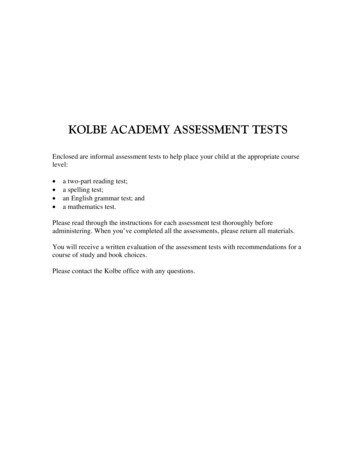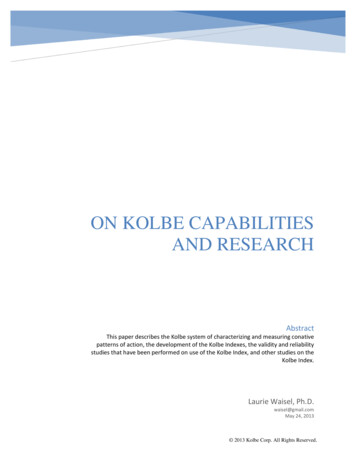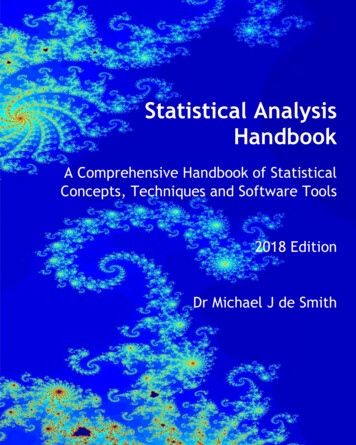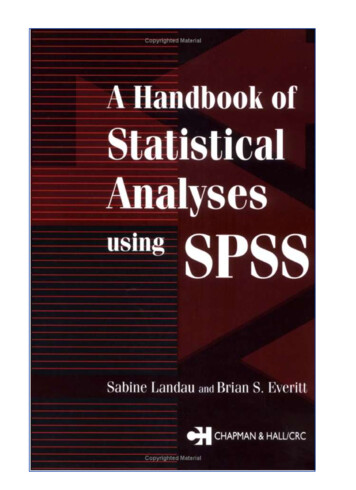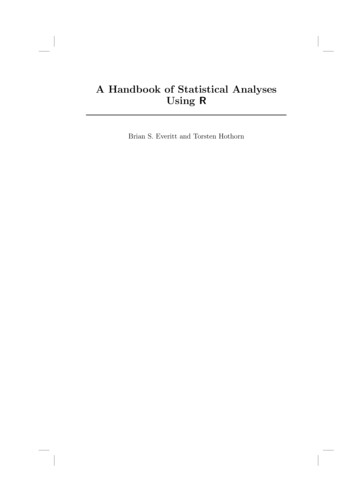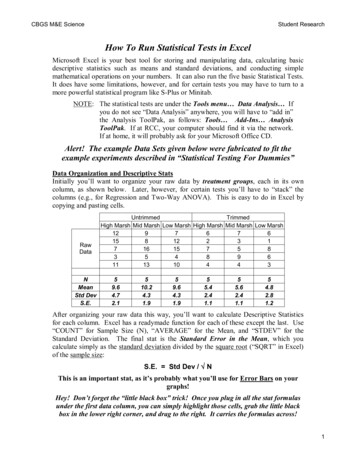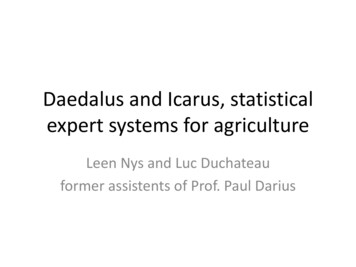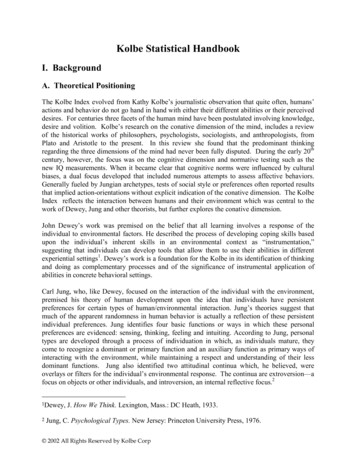
Transcription
Kolbe Statistical HandbookI. BackgroundA. Theoretical PositioningThe Kolbe Index evolved from Kathy Kolbe’s journalistic observation that quite often, humans’actions and behavior do not go hand in hand with either their different abilities or their perceiveddesires. For centuries three facets of the human mind have been postulated involving knowledge,desire and volition. Kolbe’s research on the conative dimension of the mind, includes a reviewof the historical works of philosophers, psychologists, sociologists, and anthropologists, fromPlato and Aristotle to the present. In this review she found that the predominant thinkingregarding the three dimensions of the mind had never been fully disputed. During the early 20thcentury, however, the focus was on the cognitive dimension and normative testing such as thenew IQ measurements. When it became clear that cognitive norms were influenced by culturalbiases, a dual focus developed that included numerous attempts to assess affective behaviors.Generally fueled by Jungian archetypes, tests of social style or preferences often reported resultsthat implied action-orientations without explicit indication of the conative dimension. The KolbeIndex reflects the interaction between humans and their environment which was central to thework of Dewey, Jung and other theorists, but further explores the conative dimension.John Dewey’s work was premised on the belief that all learning involves a response of theindividual to environmental factors. He described the process of developing coping skills basedupon the individual’s inherent skills in an environmental context as “instrumentation,”suggesting that individuals can develop tools that allow them to use their abilities in differentexperiential settings1. Dewey’s work is a foundation for the Kolbe in its identification of thinkingand doing as complementary processes and of the significance of instrumental application ofabilities in concrete behavioral settings.Carl Jung, who, like Dewey, focused on the interaction of the individual with the environment,premised his theory of human development upon the idea that individuals have persistentpreferences for certain types of human/environmental interaction. Jung’s theories suggest thatmuch of the apparent randomness in human behavior is actually a reflection of these persistentindividual preferences. Jung identifies four basic functions or ways in which these personalpreferences are evidenced: sensing, thinking, feeling and intuiting. According to Jung, personaltypes are developed through a process of individuation in which, as individuals mature, theycome to recognize a dominant or primary function and an auxiliary function as primary ways ofinteracting with the environment, while maintaining a respect and understanding of their lessdominant functions. Jung also identified two attitudinal continua which, he believed, wereoverlays or filters for the individual’s environmental response. The continua are extroversion—afocus on objects or other individuals, and introversion, an internal reflective focus.21Dewey,2J. How We Think. Lexington, Mass.: DC Heath, 1933.Jung, C. Psychological Types. New Jersey: Princeton University Press, 1976. 2002 All Rights Reserved by Kolbe Corp
Jung’s work is an important foundation for the Kolbe index in its recognition of the followingideas: The first is the existence of persistent patterns or types of behavior that influenceenvironmental interaction. The second is the recognition of an individual’s dominance of asingle pattern. The third is the recognition that behavioral responses can be used to measuredominance of the patterns. And finally, that there are overlays in behavior that may berepresented as a continuum between two polar positions, and that these may in turn determinehow individuals employ their cognitive or emotional responses in a specific setting.The Kolbe theory recognizes that individuals have persistent predispositions for conduciveinteractions with the world. These predispositions can be measured through behavioralmanifestations which can be reflected on a continuum. Like Isabel Myers and others who haveextended Jung’s theories, the Kolbe instrument does not measure the underlying functionsidentified by Jung, but rather focuses on the overlays that predispose an individual to apply thefunction in a particular way. For example, Myers added a “judgment-perception” preference toJung’s extroversion and introversion continua. She believes that individuals filter their functionalresponses through a filter that organizes responses in order in terms of a tendency to imposeconvergent or divergent order upon the environment3. Kolbe’s research led her to conclude thatthere was no proven reliable assessment of the conative dimension, that at the time was generallyignored. So she set out to measure and predict the outward manifestation of motivation.Through the use of observational studies, behavioral patterns were detected in a wide range ofsettings mentioned above. From these, Kolbe postulated four different continua which reflectindividuals predispositions to: 1) probe, 2) organize, 3) improvise, and 4) construct. She furtherpostulated that these patterns, like the extroversion, introversion and judgment/perceptioncontinua, were patterns that remained constant over time and influenced the manner in whichindividuals use their functional preferences. Testing confirmed the stability of the measures andtheir relative independence from the continua employed by Myers and others. Further testingestablished correlation between predispositions and job performance, and also demonstrated thatthe measures were independent of race, gender or other confounding criteria.Each pattern or creative instinct triggers observable behavior or modes of action through whichan individual performs. These four continua or modes each have an operational definition for the“insistence” zone, the primary function:3Myers, I. Introduction to Type. Palo Alto, CA: Consulting Psychologist Press, Inc., 1962. 2001 All Rights Reserved by Kolbe Corp2
An initiating Fact Finder will most likely succeed at tasks which require an individual izedefineprovespecifycalculateinquireevaluateAn initiating Follow Thru will most likely succeed at tasks which require an individual oordinatearrangeintegratescheduleplanbudgetchartAn initiating Quick Start will most likely succeed at tasks which require an individual eriskplay hunchesreformimprovisepromoteintuitAn initiating Implementor will most likely succeed at tasks which require an individual to:formmolddemonstratecraftshapeput togetherbuildrenderconstructfixrepairpracticeB. Construction of the IndexBased upon these constructs, 200 items were developed as a part of the first instrument. Adecade of research began with item analyses of those 200 questions. The test instrument wasrefined through the use of criterion-group analysis and correlation studies through which anyextraneous variables, such as cognitive or affective variables were eliminated.The instrument was first given to groups of subjects with known estimates of intelligence. Thoseitems which discriminated between individuals of varying intellectual levels were deleted fromthe instrument. The remaining items were given to subjects who had also completed theWonderlic Personnel Test, which tests on cognitive abilities. All items which distinguishedbetween subjects based on high and low scores on the Wonderlic were also removed in order toreduce bias based on cognitive differences.In continuing studies, further items were eliminated when, for subjects who had also takentraditional personality instruments, endorsement of those items revealed significant correlationwith items defining affective patterns. One of the personality instruments used was the MyersBriggs Type Indicator, whose results a 1991 National Research Council report concluded have noverifiable relationship to performance (a more detailed summary of the Council’s conclusions isprovided in Appendix A). 2001 All Rights Reserved by Kolbe Corp3
At this point, 50 of the original 200 items remained. These 50 items were then given to 200subjects, who were asked to complete the index in such a way as to attempt to present themselvesin a socially desirable manner. Those items which proved to be part of a “socially desirableresponse set” were then deleted. Of the 44 items in the pool of possible questions, 36 werefinally selected to comprise the current version of the Kolbe index. These were found to besufficient in order to maintain the accuracy of the instrument while reducing the effects ofboredom and moderating other sources of measurement errors. By including items which relateto both normal and emotionally stressful circumstances, as well as affective and cognitiveinfluences, the choices are counterbalanced.C.Test Description, Scoring & ResultsThe Kolbe A index is a forced-choice instrument that requires subjects to choose from fourresponse choices two answers reflecting how they would most and least likely respond to 36single-sentence problem-solving or behavioral scenarios.The raw scores reflect the frequency with which the subject would tend to initiate, respond to, orresist probing, organizing, improvising and constructing behaviors. These frequencies are plottedon four ten-point scales, Fact Finder (FF), Follow Thru (FT), Quick Start (QS) and Implementor(IM) that reflect the behavioral predispositions of the subjects. These four behaviors, or ActionModes , are divided into three zones: initiation, response and resistance.Percentages of mental energy available for expression via each of these Action Modes areprovided in order of dominance, Fact Finder, Quick Start, Follow Thru, Implementor. ThePersonal Productivity Pyramid in the Kolbe A index identifies the approximate amount of energyavailable for use through each mode, and suggests what will be an individual’s most efficientappropriation of committed effort. This result is not comparable to any other person’s results.The scales are generally used in conjunction with each other to establish a pattern of individuals’overall predispositions, but each sub-scale can be used independently to focus on a particularpattern in a specific context. These intensity scores for each mode vary in a mannerapproximating the normal curve, with more than 60% of respondents scoring in theaccommodation zone. Therefore, while Kolbe index results are interpreted without comparisonto others in a value-based way, it is possible to estimate a percentile ranking of available intensityin a given Action Mode.The patterns of overall predisposition yield 17 natural “insistence patterns” which are called“Natural Advantages .” These patterns, named for their singular or combined attributes, DONOT imply what would necessarily be an appropriate job title. Rather, they describe methods ofoperation or “MOs.” The 17th Natural Advantage is that of Mediator/Transition. About 10% ofthe population falls into this category which has no mode of initiation, but rather accommodatesor resists in each of the four modes. Some individuals are true Mediators, while others areundergoing temporary periods of Transition where they are unable to accurately identify theirinstinctive patterns. For a complete listing of the Natural Advantages and their characteristics,see Appendix B. 2001 All Rights Reserved by Kolbe Corp4
MONatural AdvantageMONatural OGRAM DEVELOPERFF/FTFF/IMFT/FFFT/IMSTRATEGIC PLANNERTECHNOLOGISTSYSTEMS DEMONSTRATORQUALITY PIONEERINVESTIGATORADVENTURERTRANSITIONAs discussed above, the Kolbe index does not measure the cognitive or the affective dimensionsof the mind. That is to say those variables such as intelligence, anger, anxiousness or othercomponents were removed from this index. Its focus is a conative one, investigating thepredisposition of the subject to respond to specific behavioral settings with certain patterns ofbehavior. An analysis of the scores of 268 subjects who completed both the Kolbe index and theMyers-Briggs Type Indicator (MBTI) revealed no significant correlation between individualAction Modes and MBTI indices, but some mild correlation between Quick Start and FollowThru and some facets of the S-N and J-P dimensions. Follow-up studies in May, 1992 and Fall,1997 substantiated these findings (See Appendix C).D. Application of the Kolbe Concept In order to be able to move into examining the validity and reliability of the test, anunderstanding of the Kolbe concept and its practical application should be established. TheKolbe concept as a theory states that all humans share the same four modes of operation, butdiffer in the energy distribution between the four modes. That is to say those individuals havedifferent striving instincts in the pursuit of their personal goals. The Kolbe concept furtherpredicts that the unique individual predisposition equips people with special talent. Therefore,people who work outside of their natural talents, or striving instincts, would experience a greatdeal of stress. On the other hand, people who work in harmony with their striving instinctsutilize their energy wisely and maximize their performance.This idea can be widely applied in different facets of life. On an individual basis, it provides abetter understanding of oneself. It can also be used in relationship consulting, in order tounderstand and appreciate the other. Another way the Kolbe concept can be utilized is in thebusiness world. Here, it can be used in selection processes, placement, team synergy andorganizational development.Some of the most frequent applications of the Kolbe index are in employee se
C. Test Description, Scoring & Results The Kolbe A index is a forced-choice instrument that requires subjects to choose from four response choices two answers reflecting how they would most and least likely respond to 36 single-sentence problem-solving or behavioral scenarios.

